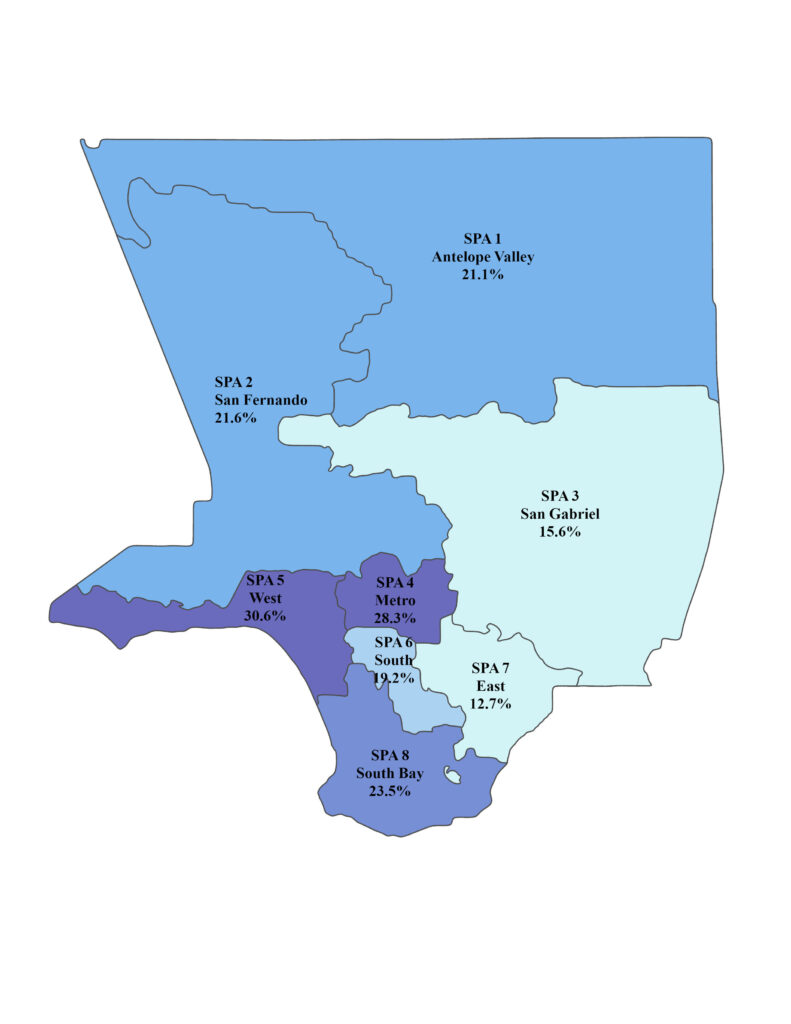Prevalence
Cannabis is the most commonly used illicit drug in the US. This has been consistent across age, gender, race/ethnicity groups, and from different national and local surveys, though the specific measures and estimates vary. This page presents the most recent data from the National Survey on Drug Use and Health (NSDUH), the California Healthy Kids Survey (CHKS), the Los Angeles County Health Survey (LACHS), the Community Needs Assessment (CNA).
National Survey on Drug Use and Health (NSDUH)
Overall Use Trends
In the US, past month cannabis use has been consistently increasing among adults in recent years, while remaining relatively stable for youth.
In 2023, there were an estimated 43.6 million people aged 12+ in the US that had used cannabis in the past month.
Cannabis use in the past month had increased from 8.6% in 2016 to 15.4% in 2023 among people aged 12+ in US.
Young adults aged 18-25 (25.2%) consistently had the highest prevalence of past month cannabis use in US (Figure 1).
In the US, past year cannabis use has been steadily increasing among adults in recent years, while remaining relatively stable for youth.
In 2023, there were an estimated 61.8 million people aged 12+ that had used cannabis in the past year in the US.
Past year cannabis use had increased from 13.9% in 2016 to 21.8% in 2023 among people aged 12+ in the US.
Young adults aged 18-25 (36.5%) consistently had the highest prevalence of past year cannabis use in the US compared to other age groups (Figure 2).
In 2023, 133.5 million people aged 12+, or nearly half (47.1%) had ever used cannabis in their lifetime.
Lifetime use of cannabis has steadily increased for people aged 26+ in the US over the past decade, from 45.7% in 2013 to 50.6% in 2023 (Figure 3).
Demographics of Users, US
In the US in 2023, the prevalence of cannabis use in the past year increased with age, peaking at 38.1% among those aged 21-25. Past year cannabis use gradually decreased with age through age 55-59 at 15.5%, then increased among those aged 60-64 at 17.5% before decreasing to 9.5% among older adults aged 65+.
Past month use of cannabis increased with age, peaking at 27.2% among those aged 26-29. Similar to past year use, past month cannabis use gradually decreased with age through age 55-59, then increased among those aged 60-64 before decreasing among older adults aged 65+ (Figure 4).
In the US in 2023, among people aged 26+, over half of males (54.6%) and nearly half of females (46.7%) had ever used cannabis.
Among young adults aged 18-25, ever use of cannabis was similar for females (51.1%) and males (49.0%).
Among youth aged 12-17, more females (15.1%) than males (11.7%) had ever used cannabis (Figure 5).
In the US in 2023, among people aged 26+, those of two or more races (69.1%) had the highest rate of cannabis use in their lifetime across race/ethnicity and age groups, while Asians (21.4%) had the lowest rate (Figure 6).
In the US in 2023, among people aged 12+, the overall rates of past month and past year cannabis use decreased with increasing income in the US.
Among youth aged 12-17 and young adults aged 18-25, those at 100-199% poverty level had the highest rates of past year and past month cannabis use (Figure 7).
In 2023, among people aged 18-22 in the US, full-time college students had lower rates of past month cannabis use than those who were not full-time college students, for both genders (Figure 8).
In 2023, among women aged 15-44 in the US, past month use of cannabis in pregnant women was 4.4%, compared to 19.6% among non-pregnant women (Figure 9).
First Use, US
In 2023, 3.5 million (1.2%) people aged 12+ in the US used cannabis for the first time in their life.
Cannabis initiation increased with age, peaking at age 16-17, then decreased. About 1.3% (n=102,000) of 12-13 year-olds , 5.5% (n=500,000) of 14-15 year-olds, 6.4% (n=567,000) of 16-17 year-olds, 5.2% (n=631,000) of 18-20 year-olds, 2.6% (n=631,000) of 21-25 year-olds, and 0.5% (n=1.1 million) of 26+ year-olds initiated cannabis use in 2023 (Figure 10).
More females than males initiated cannabis use in 2023. Overall, 2.0 million (1.4%) females and 1.5 million (1.1%) males initiated cannabis use in 2023.
Rates were similar among youth, as 4.5% (n=564,000) of females aged 12-17 and 4.6% (n=605,000) of males aged 12-17 initiated cannabis use (Figure 11).
Frequency of Use, US
In 2023, past year cannabis users aged 12+ in the US used on an average of 144.9 days of the year. Youth past year cannabis users aged 12-17 used on average 84.0 days in the past year. Adult past year cannabis users aged 26+ had the highest average frequency of use, using on average 148.4 days in the past year (Figure 12).
Over a quarter (25.5%) of past year cannabis users in the US had used cannabis daily or almost daily in 2023. Among past year cannabis users, daily or almost daily cannabis use was reported for 9.5% of youth aged 12-17, for 25.2% of young adults aged 18-25, and for 26.5% of adults aged 26+ (Figure 13). Of the total population in the US, 5.6% (n=15.7 million) of all people aged 12+, 1.1% (n=275,000) of all youth aged 12-17, 9.2% (n=3.1 million) of all young adults aged 18-25, and 5.5% of all adults aged 26+ (n=12.3 million) were daily or almost daily cannabis users.
Cannabis Use Disorder, US
In 2023, among people aged 12+ in the US, 19.2 million (6.8%) met DSM-5 criteria for a cannabis use disorder in the past year. This accounts for almost one third (31.0%) of all those that used cannabis in the past year.
In the US in 2023, among people aged 12+ with a cannabis use disorder in the past year, 10.6 million (3.7%) had a mild, 5.1 million (1.8%) had a moderate, and 3.5 million (1.2%) had a severe substance use disorder based on DSM-5 criteria (Figure 14).
In the US in 2023, people aged 18-25 had the highest prevalence rate of past year cannabis use disorder (16.6%). Among youth aged 12-17, 4.7% had a past year cannabis use disorder (Figure 15).
Overall among people aged 12+ in the US, males (8.2%) had a higher prevalence of past year cannabis use disorder compared to females (5.4%) in 2023.
Among youth aged 12-17, females (5.9%) had a higher prevalence of cannabis use disorder in the past year compared to males (3.6%).
Males aged 18-25 (18.3%) had the highest prevalence of cannabis use disorder in the past year in the US compared to all age-gender groups in 2023 (Figure 16).
In the US in 2023, the prevalence of past year cannabis use disorder among people aged 12+ was highest among American Indian/Alaskan Natives (AIAN, 12.9%) and those identifying as two or more races (12.6%), followed by Blacks (8.7%), Whites (6.7%), Latinxs (6.2%), and Asians (2.1%).
Young adults aged 18-25 identifying as multi-race (22.6%) had the highest prevalence of past year cannabis use disorder of all age-race/ethnic groups (Figure 17).
In 2023, treatment for cannabis use accounted for 13.6% (n=479,000) of all inpatient substance use disorder treatment, and 11.9% (n=1.2 million) of all outpatient substance use disorder treatment received among people aged 12+ in the US (Figure 18).
Among youth aged 12-17, treatment for cannabis use accounted for 14.2% (n=52,000) of all inpatient substance use disorder treatment, and 17.4% (n=151,000) of all outpatient substance use disorder treatment received in the US (Figure 19).
California Healthy Kids Survey (CHKS)
Secondary School Students
In LAC, any use of cannabis (i.e., smoke, vape, eat, or drink) at least once in one’s lifetime increased among youth in higher grade levels, with ever use at 16% among 11th graders, 8% among 9th graders, and 3% among 7th graders in 2021-2023. From 2011 to 2023, ever use of cannabis decreased by about two thirds across students of all grade levels (Figure 20).
Current use of cannabis (in past month) has steadily decreased among 11th graders since 2015 to 7%, and decreased among 9th graders since 2017 to 4% in 2021-2023. Current use of cannabis among 7th graders fluctuated between 1%-3% over the past decade (Figure 21).
In 2021-2023, females had a higher prevalence of current use of cannabis than males in grades 7 and 11, and had a similar rate in grade 9 (Figure 22).
In 2021-2023, the pattern of current cannabis use by race/ethnicity in LAC was different for different grades.
Among 11th graders, the rate of current use of cannabis was highest among American Indian/Alaskan Native (AIAN, 18%), followed by Blacks (12%), Whites (11%), mixed ethnics (10%), Native Hawaiian or Pacific Islanders (NHOPI, 7%) and Latinxs (7%), and Asians (3%).
Among 9th graders, Blacks (7%) had the highest prevalence of current cannabis use, followed by Latinxs (5%), mixed ethnics (4%), Whites (3%), AIAN (2%), and Asians and NHOPI (both 1%).
Among 7th graders, Latinxs had the highest prevalence of current cannabis use at 2%, while AIAN, Black, NHOPI, White, and mixed ethnics had a lower prevalence at 1%, and Asians had a prevalence of less than 1% (Figure 23).
Los Angeles County Health Survey (LACHS)
Adults
In LAC, past year use of cannabis among adults aged 18+ has been increasing consistently over the past decade, more than doubling from 8.5% in 2011 to 20.9% in 2023 (Figure 24).
In LAC in 2023, past year use of cannabis among adults peaked at ages 25-29 (36.7%), then decreased with age. Adults age 65+ had the lowest rates of past year use of cannabis (11%) (Figure 25).
In LAC in 2023, among adults, males (23%) used cannabis at a higher rate than females (18.1%) (Figure 26).
In LAC in 2023, adults identifying as multi-race or other race (37.4%) had the highest prevalence of past year use of cannabis, while Asians (12.9%) had the lowest (Figure 27).
In LAC in 2023, adult cannabis use in the past year was highest in SPA 5 – West (30.6%) and SPA 4 – Metro (28.3%), and lowest in SPA 7 – East (12.7%) (Figure 28).
Figure 28. Past year use of cannabis among adults 18+ by Service Planning Area, LAC, 2023
Source: LACHS

Community Needs Assessment (CNA)
In 2022, 36.5% of LAC residents had ever used cannabis in their lifetime, and 13.8% LAC residents were current cannabis users (used in the past 30 days).
Compared to those who had never used cannabis, those who had ever used cannabis were more likely to have close friends (80.3% vs. 25.1%) and family members (66.6% vs. 20.2%) who used cannabis.
In LAC in 2022, ever use of cannabis increased with age, peaking at 57.4% for adults aged 21-29, then decreased with age. Among the underage groups, 18.4% of youth aged 12-17 and 45.4% of underage adults aged 18-20 had ever used cannabis. Among adults aged 40+, 29.0% had ever used cannabis (Figure 29).
Similarly, current use of cannabis residents peaked at 27.5% for adults aged 21 to 29, then decreased with age (Figure 30). Current cannabis users aged 21-39 used cannabis on an average of 15 days in the past 30 days. The frequency of cannabis use for current cannabis users was lower among youth aged 12-17 at 11 days, and among underage adults aged 18-20 at 12 days on average (Figure 31).
In 2022 in LAC, ever and current cannabis use was higher among males than females (Figures 32-33). Among current users, males used cannabis on 16 days in the past month, while females used on 12 days in the past month on average (Figures 34).
In LAC in 2022, ever use of cannabis was highest among Native Americans (69.3%), followed by Whites (53.9%) and Blacks (53.6%), multi-race (50.5%), NHOPI (49.9%), Latinxs (33.5%), and Asians (26.2%) (Figure 35).
Current cannabis use was highest among Blacks (25.1%), but Native Americans had the highest average number of cannabis use days (mean=20 days) among current cannabis users (Figures 36-37).
References
Substance Abuse and Mental Health Services Administration. (SAMHSA). The National Survey on Drug Use and Health (NSDUH). https://www.samhsa.gov/data/release/2023-national-survey-drug-use-and-health-nsduh-releases
California Healthy Kids Survey (CHKS). WestEd, California Healthy Kids Survey (CHKS) & Biennial State CHKS. California Dept. of Education (Aug. 2020). https://calschls.org/reports-data/search-lea-reports/
Los Angeles County (LAC) Substance Abuse prevention and Control (SAPC) Community Needs Assessment (CNA). 2022. Retrieved from http://ph.lacounty.gov/sapc/MDU/SpecialReport/Marijuana-Use-and-Public-Perceptions-in-Los-Angeles-County.pdf. Retrieved 4/8/2024.


